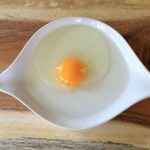 Storage tissues accompanying the embryo (endosperm and perisperm) [antiquated term].
Storage tissues accompanying the embryo (endosperm and perisperm) [antiquated term].
The watery jelly that surrounds the yolk of an egg is a protein called albumen, a form of which is also abundant in human blood. When heated, egg albumen turns white, a transformation that is suggested by the origin of the word itself: albumen derives from the Latin albus, meaning white. The Latin albus is obviously the source of the word albino, denoting a creature deficient in pigmenation, but is less obviously the source of album. The connection is that albums were originally blank tablets upon whose white surfaces ancient Roman scribes recorded public edicts. Another word that also derives from the Latin albus is aubade, the name of a song that lovers traditionally sing when they are forced to part at dawn, that is, when the sky begins to whiten. Oddly, even auburn, which now denotes reddish brown, derives from albus. Colour words are notoriously slippery in their application: for example, in the Middle Ages the word scarlet was sometimes used to denote blue, while the word purple was once used to denote red. One final relative of albumen, albino, aubade, and auburn is elf: the Latin source of those words, albus, evolved from an even older Indo-European ancestor pronounced something like albho, meaning white. Through the Germanic language branch of Indo-European, albho developed into elf, thanks to the notion that such creatures had a white and ghostly pallor.
